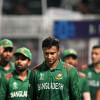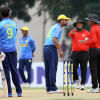Has the Bangladesh cricket team reached their ceiling?

The end of a disappointing world cup means fans would rather stop thinking about these last nine matches as soon as possible, and they will. But administrators shouldn't have that luxury. In between the humiliating defeats and the inexplicable performances, if there is any semblance of a silver lining, it could be that this world cup has been an eye opener. One of the best prepared ODI teams in the history of Bangladesh cricket could only muster two wins against the best in the world. Could they have done better? Or is this the limit of their abilities?
It could be argued that a more conducive environment could have been provided for the team, with stability in leadership and harmony among star players. The argument would be sound, but Bangladesh didn't lose any of their games in close encounters. The margins of losses and the nature in which the team wilted indicated a real gulf in quality, or at least a lack of self-belief. Players are human beings; they are individuals who have trained their entire lives to become professional cricketers, to get to the world stage for an opportunity to prove themselves. It would be a disservice to their lifelong struggles to assume that they would allow petty drama and ego contests to get in the way of their shot at glory. Should the realisation be that the rest of the world had raced forward into an era of cricket that is far more modern and aggressive than the brand played by Bangladesh? That would take the wind out of the sails of even the most motivated athlete in the world.
But how could that happen? Cricket gets so much priority in this country. The Bangladesh Cricket Board is by far the richest and the most high-profile sports governance body in the country. There is money in cricket, and there is fan interest; it doesn't make sense that cricket in Bangladesh could fall so far behind the eight ball. Well, it doesn't make sense right until you start looking at the details, and then it all falls into place.
Much of Bangladesh's success in ODI cricket has come during a period when most other cricketing nations have focused on Tests and T20Is. ICC held two world T20 events in the last three years, and while Bangladesh's performance in those events were lacklustre, they ranked third on the table of the confusingly named ICC Men's Cricket World Cup Super League (a league where every national team played 24 ODIs between the years of 2020-2022). But this performance has some important asterisks attached to it.
Bangladesh did not play Australia, India, or Pakistan as part of this league. The series Bangladesh won included home contests against Afghanistan, Sri Lanka, and West Indies, and away against Zimbabwe, Ireland, and South Africa. Bangladesh lost two series against England and New Zealand, the first at home and the other away. The team also won a series against India at home during this time, an achievement of miraculous proportions owing to the performances of Mehidy Hasan Miraz. The heavy reliance on home conditions and the tendency to only play lower ranked sides instead of the best in the world has possibly painted a fictitious picture of the calibre of Bangladesh's ODI team. The away win against South Africa could be pointed to as proof that the team had matured, but it could also be pointed to as an anomaly. South Africa have beaten touring sides from India, England, and Australia in ODIs before and after Bangladesh, and clearly those sides are better than us.
Add to that the fact that most national team matches take place in Mirpur, a ground where the pitch is often low and slow. While Bangladesh have excelled in these conditions, the rest of the world has moved on towards pursuing higher scores, with faster pitches that are conducive to batting. National team cricketers, especially the batters, have spoken up about the need for better pitches. Nazmul Hossain Shanto urged the BCB for more sporting wickets, and Towhid Hridoy said playing more games on tracks like the ones found in Sylhet and Chattogram will help the batters get used to scoring 300 or 350.
The domestic circuit must be looked at too. The BCB needs to sufficiently support domestic cricketers through finances and facilities, so that these cricketers are motivated to take their game to the next level for the national team, and only then will there be a pipeline of cricketers ready to represent the country. The current model of relying on talented individuals to show themselves and take the game to the next level is bound to falter, like it has now. Talent acquisition in Bangladeshi cricket is poor. Simply consider the fact that in 2019, the team was desperate for a leg spinner. In 2023, we still don't have one.
If things don't change, if home matches against good teams are played on the drab pitches of Mirpur, if domestic cricket continues to be neglected in terms of endorsement and planning, if the BCB cannot negotiate more matches away at India, England, and Australia, and if a leg spinner cannot be produced for the national team, it is fair to say that Bangladesh cricket has reached a ceiling. It's up to the administrators now to take a long hard look at things, and raise that ceiling. Otherwise, once the likes of Shakib and Tamim leave, we are in for dark, dark days.
Azmin Azran is a journalist at The Daily Star.
Follow The Daily Star Opinion on Facebook for the latest opinions, commentaries and analyses by experts and professionals. To contribute your article or letter to The Daily Star Opinion, see our guidelines for submission.

 For all latest news, follow The Daily Star's Google News channel.
For all latest news, follow The Daily Star's Google News channel. 









Comments